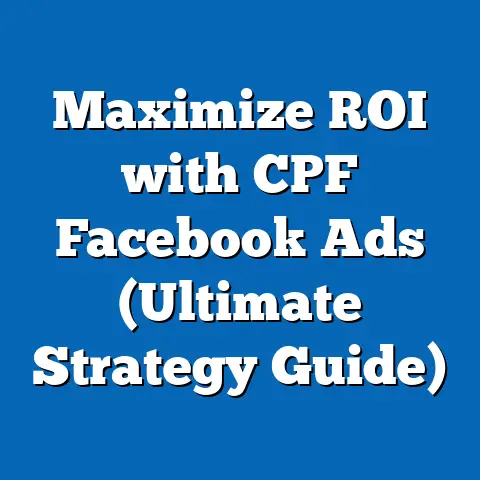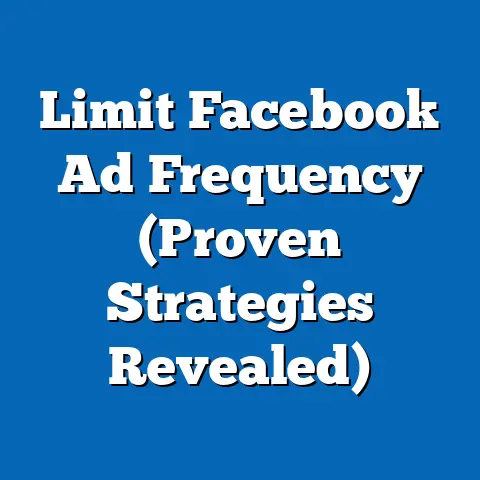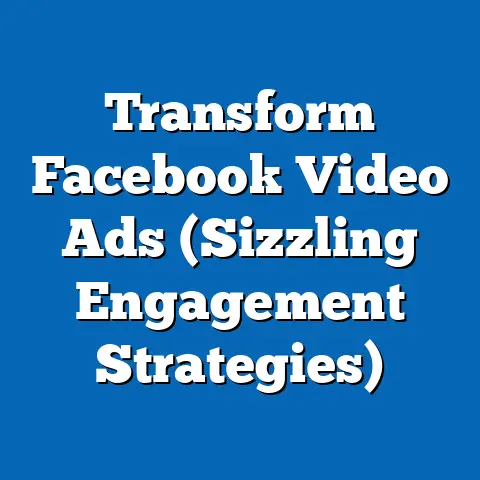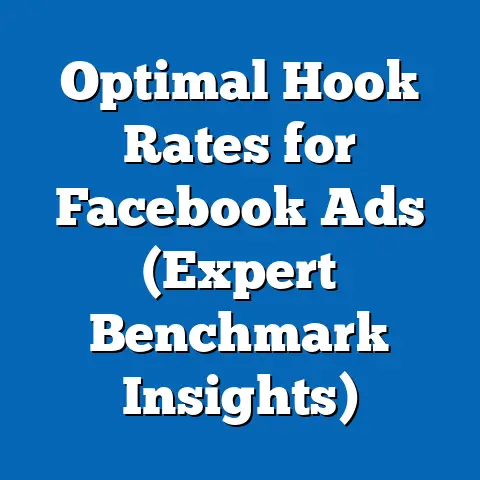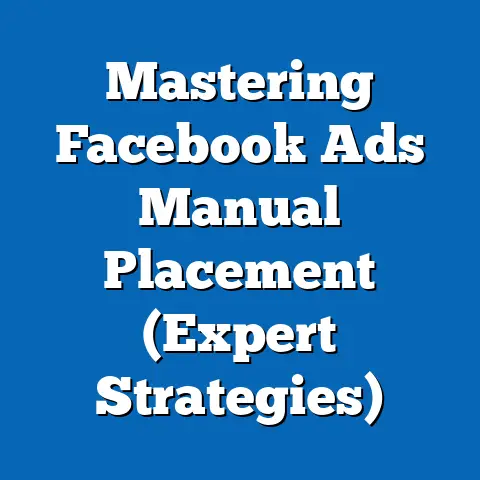Maximize Mobile Reach with Facebook Ads (Proven Strategies)
Let’s talk about warmth for a second. In the often cold and impersonal world of digital marketing, warmth is the key to unlocking real connection. It’s about building trust, creating a sense of familiarity, and making your audience feel seen and understood. Think of it like offering a virtual cup of coffee – a welcoming gesture that invites them to engage with you.
Now, consider mobile marketing. It’s no longer a trend; it’s the reality. We’re glued to our phones, scrolling through social media, browsing the web, and making purchases on the go. If you’re not reaching your audience on mobile, you’re missing out on a massive opportunity.
That’s where Facebook Ads come in. They’re a powerful tool for connecting with mobile users, but only if you use them strategically. It’s not enough to just throw up an ad and hope for the best. You need a plan, a deep understanding of the mobile landscape, and a willingness to adapt and optimize.
In this article, I’m going to share proven strategies for maximizing your mobile reach with Facebook Ads. I’ll walk you through everything from understanding the mobile landscape to crafting compelling ad content, leveraging advanced features, and measuring your ROI. I’ll share my experiences and insights, some hard-won lessons, and the strategies that have consistently delivered results for me and my clients.
Think of this as your complete guide to mobile Facebook Ads success. Let’s dive in!
Section 1: Understanding the Mobile Landscape
The mobile revolution isn’t coming; it’s here. To effectively leverage Facebook Ads for mobile reach, you need to grasp the sheer scale and dynamics of the mobile landscape. Let’s look at some key statistics and trends:
- Global Mobile Usage: Statista reports that there are over 7 billion mobile phone users worldwide in 2024, and a significant portion of their online time is spent on social media platforms like Facebook.
- Facebook Mobile Dominance: Facebook’s own data consistently shows that a vast majority of its users access the platform via mobile devices. In fact, mobile advertising revenue accounts for a substantial portion of Facebook’s total ad revenue.
- Consumer Behavior Shift: Mobile devices have become the primary screen for many, influencing how people discover, research, and purchase products and services. Think about your own habits – how often do you reach for your phone to check social media, look up a restaurant, or make a quick purchase?
Trends in Consumer Behavior:
- Mobile-First Indexing: Google prioritizes mobile-friendly websites in its search results, highlighting the importance of a seamless mobile experience for all businesses. This has a knock-on effect for advertising, as users expect a similarly smooth experience when clicking through from a Facebook Ad to a website.
- Micro-Moments: Google coined this term to describe the intent-rich moments when people turn to their mobile devices to act on a need – whether it’s to know, go, do, or buy. Facebook Ads can be strategically placed to capture these micro-moments.
- Social Commerce: Mobile devices have fueled the growth of social commerce, where users discover and purchase products directly within social media platforms. Facebook Shops and Instagram Shopping are prime examples of this trend.
Challenges and Opportunities:
While the mobile landscape presents tremendous opportunities, it also comes with its own set of challenges:
- Attention Span: Mobile users have shorter attention spans and are easily distracted. Your ads need to grab their attention quickly and deliver a clear, compelling message.
- Small Screen Size: Designing ads for small screens requires careful consideration of visual hierarchy, text size, and overall layout. Cluttered or poorly designed ads will be ignored.
- Data Privacy: With increasing concerns about data privacy, it’s crucial to be transparent about how you’re collecting and using user data for targeting purposes.
How Facebook Ads Can Help:
Despite these challenges, Facebook Ads offer powerful tools to overcome them:
- Precise Targeting: Facebook’s granular targeting options allow you to reach specific mobile users based on demographics, interests, behaviors, and location.
- Mobile-Optimized Ad Formats: Facebook offers a variety of ad formats specifically designed for mobile devices, including Stories, Carousel ads, and Instant Experiences.
- Performance Tracking: Facebook Ads Manager provides detailed analytics to track the performance of your mobile ads and identify areas for improvement.
My Experience:
I remember working with a local restaurant that was struggling to attract new customers. We decided to focus on mobile advertising using Facebook Ads. We targeted users within a 5-mile radius of the restaurant who were interested in food and dining. We created a series of mobile-optimized ads featuring mouth-watering photos of their dishes and a special offer for first-time customers. The results were incredible – we saw a significant increase in foot traffic and online orders. This experience reinforced the power of mobile advertising when done right.
Key Takeaway:
Understanding the mobile landscape is the foundation for successful mobile Facebook Ads campaigns. By staying informed about the latest trends and challenges, you can tailor your strategies to effectively reach and engage your target audience on mobile devices.
Next Steps:
- Research the latest mobile usage statistics for your target market.
- Analyze your website’s mobile traffic and identify areas for improvement.
- Familiarize yourself with Facebook’s mobile ad formats and targeting options.
Section 2: Setting Up Your Facebook Ads for Mobile Success
Now that you have a solid understanding of the mobile landscape, let’s get practical. Setting up your Facebook Ads campaign correctly from the start is crucial for achieving mobile success. Here’s a step-by-step guide:
-
Campaign Objective: Choose an objective that aligns with your mobile marketing goals. Common options include:
- Reach: Maximize the number of mobile users who see your ad.
- Traffic: Drive mobile users to your website or app.
- Engagement: Increase likes, comments, shares, and other interactions on your mobile ads.
- App Installs: Encourage mobile users to download your app.
- Lead Generation: Collect leads from mobile users through a Facebook Lead Ad.
- Conversions: Drive specific actions on your website or app, such as purchases or sign-ups.
-
Targeting: Leverage Facebook’s targeting options to reach your ideal mobile audience:
- Location: Target mobile users based on their current location or places they frequent.
- Demographics: Narrow your audience by age, gender, education, and other demographic factors.
- Interests: Reach mobile users based on their interests, hobbies, and activities.
- Behaviors: Target mobile users based on their online behavior, such as purchase history or device usage.
- Custom Audiences: Upload your own customer data to create custom audiences of mobile users.
- Lookalike Audiences: Expand your reach by targeting mobile users who are similar to your existing customers.
-
Ad Placement: Choose mobile-optimized ad placements:
- Facebook Feed: Ads appear in the news feed on mobile devices.
- Instagram Feed: Ads appear in the Instagram feed on mobile devices.
- Facebook Stories: Full-screen, vertical ads that appear between user stories.
- Instagram Stories: Similar to Facebook Stories, but on Instagram.
- Audience Network: Extend your reach to mobile apps and websites outside of Facebook and Instagram.
-
Budget and Schedule: Set a budget and schedule for your mobile ad campaign:
- Daily Budget: The average amount you’re willing to spend each day.
- Lifetime Budget: The total amount you’re willing to spend over the entire campaign.
- Schedule: Choose when you want your ads to run, based on your target audience’s mobile usage patterns.
-
Ad Format: Select a mobile-friendly ad format that aligns with your campaign objective:
- Single Image Ad: A simple ad with a single image or video.
- Carousel Ad: Showcase multiple images or videos in a scrolling format.
- Video Ad: Engage mobile users with short, attention-grabbing videos.
- Instant Experience Ad: A full-screen, interactive ad experience that loads instantly on mobile devices.
- Collection Ad: Display a catalog of products in a visually appealing format.
Campaign Objective: Choose an objective that aligns with your mobile marketing goals. Common options include:
- Reach: Maximize the number of mobile users who see your ad.
- Traffic: Drive mobile users to your website or app.
- Engagement: Increase likes, comments, shares, and other interactions on your mobile ads.
- App Installs: Encourage mobile users to download your app.
- Lead Generation: Collect leads from mobile users through a Facebook Lead Ad.
- Conversions: Drive specific actions on your website or app, such as purchases or sign-ups.
Targeting: Leverage Facebook’s targeting options to reach your ideal mobile audience:
- Location: Target mobile users based on their current location or places they frequent.
- Demographics: Narrow your audience by age, gender, education, and other demographic factors.
- Interests: Reach mobile users based on their interests, hobbies, and activities.
- Behaviors: Target mobile users based on their online behavior, such as purchase history or device usage.
- Custom Audiences: Upload your own customer data to create custom audiences of mobile users.
- Lookalike Audiences: Expand your reach by targeting mobile users who are similar to your existing customers.
Ad Placement: Choose mobile-optimized ad placements:
- Facebook Feed: Ads appear in the news feed on mobile devices.
- Instagram Feed: Ads appear in the Instagram feed on mobile devices.
- Facebook Stories: Full-screen, vertical ads that appear between user stories.
- Instagram Stories: Similar to Facebook Stories, but on Instagram.
- Audience Network: Extend your reach to mobile apps and websites outside of Facebook and Instagram.
Budget and Schedule: Set a budget and schedule for your mobile ad campaign:
- Daily Budget: The average amount you’re willing to spend each day.
- Lifetime Budget: The total amount you’re willing to spend over the entire campaign.
- Schedule: Choose when you want your ads to run, based on your target audience’s mobile usage patterns.
Ad Format: Select a mobile-friendly ad format that aligns with your campaign objective:
- Single Image Ad: A simple ad with a single image or video.
- Carousel Ad: Showcase multiple images or videos in a scrolling format.
- Video Ad: Engage mobile users with short, attention-grabbing videos.
- Instant Experience Ad: A full-screen, interactive ad experience that loads instantly on mobile devices.
- Collection Ad: Display a catalog of products in a visually appealing format.
Mobile-Friendly Ad Formats: Examples & Best Practices
- Stories Ads: These full-screen, vertical ads are incredibly engaging. Use eye-catching visuals, short and punchy copy, and a clear call to action. I’ve found that behind-the-scenes content and quick tutorials work exceptionally well.
- Carousel Ads: Great for showcasing multiple products or highlighting different features of a single product. Each card in the carousel can have its own link, allowing users to explore different aspects of your offering. I often use these for e-commerce clients to showcase their latest collections.
- Instant Experience Ads: These are essentially mini-landing pages within Facebook. They load instantly and provide a rich, immersive experience for users. Think of them as a way to tell a story or showcase your brand in a more engaging way. I recommend using these for product launches or to explain complex concepts.
Leveraging Facebook’s Targeting Options:
- Location Targeting: If you’re a local business, location targeting is your best friend. You can target users within a specific radius of your store or event. I’ve used this effectively for promoting local events and driving foot traffic.
- Demographic Filters: Don’t underestimate the power of demographics. Targeting users based on age, gender, education, and job title can significantly improve your ad performance. I once worked with a client selling educational courses and saw a huge improvement in conversions when we narrowed our audience to specific age groups and educational backgrounds.
My Experience:
I once ran a campaign for a mobile app that was designed to help people track their fitness goals. We decided to use the “App Installs” objective and target users who were interested in fitness, health, and wellness. We created a series of video ads showcasing the app’s features and benefits. We also used lookalike audiences to reach users who were similar to our existing app users. The campaign was a huge success – we saw a significant increase in app installs and a positive ROI.
Key Takeaway:
Setting up your Facebook Ads campaign for mobile success requires careful planning and attention to detail. By choosing the right objective, targeting the right audience, selecting mobile-optimized ad placements, and using engaging ad formats, you can maximize your reach and achieve your mobile marketing goals.
Next Steps:
- Create a Facebook Ads account (if you don’t already have one).
- Define your mobile marketing goals and objectives.
- Research your target audience’s mobile usage patterns.
- Experiment with different ad formats and targeting options.
Section 3: Crafting Compelling Ad Content for Mobile
You’ve got your campaign set up and your targeting dialed in. Now it’s time to create ad content that grabs attention and drives action. Remember, mobile users are easily distracted, so your ads need to be concise, engaging, and visually appealing.
Concise and Engaging Ad Copy:
- Headline: Your headline is the first thing mobile users will see, so make it count. Use strong verbs, numbers, and keywords to grab their attention. Keep it short and to the point – aim for under 25 characters.
- Description: Use your description to elaborate on your headline and highlight the benefits of your product or service. Keep it concise and focused – aim for under 90 characters.
- Call to Action: Tell mobile users exactly what you want them to do – “Shop Now,” “Learn More,” “Download Now,” etc. Use a clear and compelling call to action that encourages them to take the next step.
Visual Content Optimization:
- Images: Use high-quality images that are visually appealing and relevant to your target audience. Optimize your images for mobile viewing by using the recommended dimensions and file sizes.
- Videos: Video ads are incredibly effective on mobile devices. Create short, attention-grabbing videos that showcase your product or service in action. Optimize your videos for mobile viewing by using vertical or square formats.
- Branding: Make sure your brand is clearly visible in your ads. Use your logo, colors, and fonts to create a consistent brand identity.
Examples of Successful Mobile Ad Campaigns:
- Dollar Shave Club: Their humorous and relatable video ads went viral, driving massive brand awareness and sales.
- Airbnb: Their visually stunning images and videos showcase unique travel experiences, inspiring mobile users to book their next adventure.
- Nike: Their empowering and motivational ads resonate with athletes of all levels, encouraging them to push their limits.
Analyzing What Makes Them Effective:
- Relevance: The ads are highly relevant to the target audience’s interests and needs.
- Value: The ads offer a clear value proposition – whether it’s a discount, a solution to a problem, or an inspiring message.
- Visual Appeal: The ads are visually stunning and optimized for mobile viewing.
- Call to Action: The ads have a clear and compelling call to action that encourages users to take the next step.
My Experience:
I once worked with a fashion brand that was struggling to connect with mobile users. Their ads were generic and uninspired, and they weren’t seeing the results they wanted. We decided to revamp their ad content by focusing on high-quality images, concise ad copy, and a clear call to action. We also started using video ads to showcase their latest collections. The results were dramatic – we saw a significant increase in engagement, click-through rates, and sales.
Key Takeaway:
Crafting compelling ad content is essential for capturing attention on mobile devices. By using concise ad copy, optimizing visual content, and analyzing successful campaigns, you can create ads that resonate with your target audience and drive results.
Next Steps:
- Brainstorm ideas for compelling ad copy and visuals.
- Research successful mobile ad campaigns in your industry.
- Create a series of A/B tests to optimize your ad content.
Section 4: Leveraging Facebook’s Ad Features for Maximum Reach
Facebook Ads Manager is packed with features designed to help you maximize your reach and optimize your campaigns. Let’s explore some of the most powerful tools for mobile advertising:
- Retargeting: Retargeting allows you to show ads to mobile users who have previously interacted with your website, app, or Facebook page. This is a highly effective way to re-engage potential customers and drive conversions. I’ve seen retargeting campaigns consistently outperform standard campaigns in terms of ROI.
- Lookalike Audiences: Lookalike audiences allow you to reach new mobile users who are similar to your existing customers. This is a great way to expand your reach and find new potential customers. Facebook’s algorithm is surprisingly accurate at identifying users with similar characteristics.
- Dynamic Ads: Dynamic ads allow you to automatically show relevant products to mobile users based on their browsing history. This is a great way to personalize the ad experience and increase sales. If you have an e-commerce store, dynamic ads are a must-have.
A/B Testing:
- Importance: A/B testing is crucial for refining and optimizing your mobile ad campaigns. It allows you to test different ad variations and identify which ones perform best.
- Process: Create two or more versions of your ad with slight variations (e.g., different headlines, images, or call-to-actions). Run the ads simultaneously and track their performance. Use the data to identify the winning variation and implement it in your campaign. I typically run A/B tests for at least a week to gather statistically significant data.
- Mobile-Specific Testing: Focus on testing elements that are particularly important for mobile devices, such as image size, video length, and call-to-action placement.
Facebook Analytics:
- Role: Facebook Analytics provides valuable insights into mobile user behavior and allows you to track the performance of your ads.
- Understanding Mobile User Behavior: Use Facebook Analytics to understand how mobile users are interacting with your ads, website, and app. Track metrics such as page views, app installs, conversions, and engagement.
- Adjusting Strategies: Use the data from Facebook Analytics to adjust your strategies and optimize your campaigns. Identify areas for improvement and make changes accordingly.
My Experience:
I worked with an e-commerce client who was struggling to increase sales on mobile devices. We decided to implement retargeting and dynamic ads. We retargeted mobile users who had abandoned their shopping carts with ads featuring the products they had left behind. We also used dynamic ads to show mobile users relevant products based on their browsing history. The results were impressive – we saw a significant increase in sales and a positive ROI.
Key Takeaway:
Leveraging Facebook’s ad features is essential for maximizing your reach and optimizing your mobile ad campaigns. By using retargeting, lookalike audiences, dynamic ads, A/B testing, and Facebook Analytics, you can create more effective ads and achieve better results.
Next Steps:
- Set up retargeting and lookalike audiences for your mobile ad campaigns.
- Implement dynamic ads for your e-commerce store.
- Start A/B testing your ad content to optimize performance.
- Use Facebook Analytics to track the performance of your ads and adjust your strategies accordingly.
Section 5: Utilizing Mobile-Specific Strategies
To truly maximize your mobile reach with Facebook Ads, you need to embrace mobile-specific strategies that cater to the unique characteristics of mobile devices and user behavior.
-
Location-Based Advertising:
- Significance: Mobile devices are inherently location-aware, making location-based advertising a powerful tool for targeting mobile users effectively.
- Targeting Options: Facebook allows you to target mobile users based on their current location or places they frequent. You can target users within a specific radius of your store, event, or competitor’s location.
- Real-World Examples: A restaurant can target mobile users who are near their location during lunchtime with ads featuring special offers. A retail store can target mobile users who are near their store with ads featuring new arrivals. I’ve used this successfully for promoting local events and driving foot traffic to brick-and-mortar stores.
-
Call-to-Action Buttons:
- Benefits: Call-to-action buttons are essential for encouraging mobile users to take the next step. They provide a clear and concise way for users to interact with your ads.
- Mobile-Optimized Interaction: Use call-to-action buttons that are optimized for mobile interaction, such as “Shop Now,” “Learn More,” “Download Now,” “Call Now,” and “Get Directions.”
- Examples: An e-commerce store can use the “Shop Now” button to drive mobile users to their product pages. A service provider can use the “Call Now” button to encourage mobile users to contact them directly. I always emphasize the importance of a clear and compelling CTA in my campaigns.
-
Timing and Scheduling:
- Insights: Mobile usage patterns vary throughout the day. Understanding when your target audience is most active on mobile devices is crucial for maximizing the effectiveness of your ads.
- Peak Mobile Usage Times: Research your target audience’s mobile usage patterns and schedule your ads to run during peak times. For example, mobile usage tends to be higher during lunch breaks, evenings, and weekends.
- Scheduling Ads: Use Facebook’s ad scheduling feature to run your ads during specific times of the day or week. This allows you to optimize your budget and reach the right audience at the right time.
Location-Based Advertising:
- Significance: Mobile devices are inherently location-aware, making location-based advertising a powerful tool for targeting mobile users effectively.
- Targeting Options: Facebook allows you to target mobile users based on their current location or places they frequent. You can target users within a specific radius of your store, event, or competitor’s location.
- Real-World Examples: A restaurant can target mobile users who are near their location during lunchtime with ads featuring special offers. A retail store can target mobile users who are near their store with ads featuring new arrivals. I’ve used this successfully for promoting local events and driving foot traffic to brick-and-mortar stores.
Call-to-Action Buttons:
- Benefits: Call-to-action buttons are essential for encouraging mobile users to take the next step. They provide a clear and concise way for users to interact with your ads.
- Mobile-Optimized Interaction: Use call-to-action buttons that are optimized for mobile interaction, such as “Shop Now,” “Learn More,” “Download Now,” “Call Now,” and “Get Directions.”
- Examples: An e-commerce store can use the “Shop Now” button to drive mobile users to their product pages. A service provider can use the “Call Now” button to encourage mobile users to contact them directly. I always emphasize the importance of a clear and compelling CTA in my campaigns.
Timing and Scheduling:
- Insights: Mobile usage patterns vary throughout the day. Understanding when your target audience is most active on mobile devices is crucial for maximizing the effectiveness of your ads.
- Peak Mobile Usage Times: Research your target audience’s mobile usage patterns and schedule your ads to run during peak times. For example, mobile usage tends to be higher during lunch breaks, evenings, and weekends.
- Scheduling Ads: Use Facebook’s ad scheduling feature to run your ads during specific times of the day or week. This allows you to optimize your budget and reach the right audience at the right time.
My Experience:
I worked with a local coffee shop that wanted to increase its morning sales. We decided to implement location-based advertising and target mobile users who were near the coffee shop during the morning commute. We created ads featuring special offers on coffee and pastries. We also used the “Get Directions” call-to-action button to make it easy for mobile users to find the coffee shop. The results were fantastic – we saw a significant increase in morning sales and a positive ROI.
Key Takeaway:
Utilizing mobile-specific strategies is essential for maximizing your reach and engagement with mobile users. By using location-based advertising, optimizing call-to-action buttons, and timing your ads effectively, you can create more relevant and impactful mobile ad campaigns.
Next Steps:
- Implement location-based advertising for your mobile ad campaigns.
- Optimize your call-to-action buttons for mobile interaction.
- Research your target audience’s mobile usage patterns and schedule your ads accordingly.
Section 6: Measuring Success and ROI on Mobile Campaigns
You’ve implemented all the strategies we’ve discussed, but how do you know if they’re working? Measuring the success of your mobile Facebook Ads campaigns is crucial for understanding your ROI and identifying areas for improvement.
Key Performance Indicators (KPIs):
- Reach: The number of unique mobile users who saw your ad.
- Impressions: The number of times your ad was displayed to mobile users.
- Click-Through Rate (CTR): The percentage of mobile users who clicked on your ad.
- Cost Per Click (CPC): The average cost you paid for each click on your ad.
- Conversion Rate: The percentage of mobile users who completed a desired action, such as making a purchase or signing up for a newsletter.
- Cost Per Acquisition (CPA): The average cost you paid for each conversion.
- Return on Ad Spend (ROAS): The amount of revenue you generated for every dollar you spent on advertising.
Tools and Methodologies:
- Facebook Ads Manager: Provides detailed analytics to track the performance of your mobile ads.
- Facebook Analytics: Offers insights into mobile user behavior and allows you to track conversions and engagement.
- Google Analytics: Track website traffic and conversions from your mobile Facebook Ads campaigns.
- Attribution Modeling: Use attribution modeling to understand how different touchpoints in the customer journey contribute to conversions.
Analyzing Ad Performance:
- Mobile Engagement: Track metrics such as likes, comments, shares, and video views to understand how mobile users are engaging with your ads.
- Conversion Rates: Monitor your conversion rates to see how effectively your ads are driving desired actions.
- ROI: Calculate your ROI to determine whether your mobile Facebook Ads campaigns are generating a positive return on investment.
Case Studies:
- Example 1: E-commerce Brand: An e-commerce brand implemented mobile Facebook Ads campaigns targeting users interested in fashion. They saw a significant increase in website traffic, sales, and ROI. Their key strategies included using high-quality images, concise ad copy, and a clear call to action. They also used retargeting to re-engage users who had abandoned their shopping carts.
- Example 2: Local Restaurant: A local restaurant implemented location-based mobile Facebook Ads campaigns targeting users near their location during lunchtime. They saw a significant increase in foot traffic and online orders. Their key strategies included offering special discounts and using the “Get Directions” call-to-action button.
My Experience:
I worked with a subscription box company that was struggling to track the ROI of their mobile Facebook Ads campaigns. We implemented conversion tracking and attribution modeling to better understand how their ads were contributing to sales. We discovered that their retargeting campaigns were generating the highest ROI, while their prospecting campaigns were less effective. We adjusted their budget allocation accordingly and saw a significant improvement in overall ROI.
Key Takeaway:
Measuring the success of your mobile Facebook Ads campaigns is essential for understanding your ROI and identifying areas for improvement. By tracking key performance indicators, using analytics tools, and analyzing ad performance, you can optimize your campaigns and achieve better results.
Next Steps:
- Implement conversion tracking for your mobile Facebook Ads campaigns.
- Use attribution modeling to understand how different touchpoints contribute to conversions.
- Track key performance indicators and analyze ad performance regularly.
- Adjust your strategies based on your findings.
Conclusion
Maximizing mobile reach with Facebook Ads is no longer a luxury; it’s a necessity for businesses looking to thrive in today’s digital landscape. I’ve shared proven strategies that can help you connect with your target audience on mobile devices, drive engagement, and achieve your marketing goals.
Remember, the mobile landscape is constantly evolving. New trends emerge, algorithms change, and user behaviors shift. It’s crucial to stay updated on the latest developments and adapt your strategies accordingly.
Don’t be afraid to experiment, test new ideas, and learn from your mistakes. The more you experiment, the more you’ll discover what works best for your business.
Here’s a quick recap of the key strategies we covered:
- Understand the mobile landscape and tailor your strategies accordingly.
- Set up your Facebook Ads campaign for mobile success.
- Craft compelling ad content that grabs attention on mobile devices.
- Leverage Facebook’s ad features for maximum reach.
- Utilize mobile-specific strategies to connect with your target audience.
- Measure your success and ROI to optimize your campaigns.
By implementing these strategies, you can enhance your mobile advertising efforts and achieve greater engagement and conversions. So, go out there, put these strategies into action, and start maximizing your mobile reach with Facebook Ads! The world of mobile marketing awaits, and with the right approach, you can unlock its full potential.


